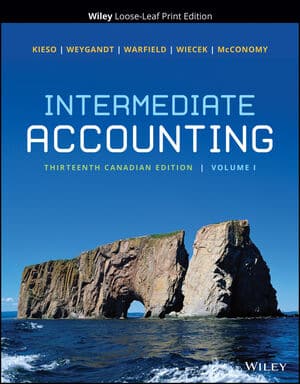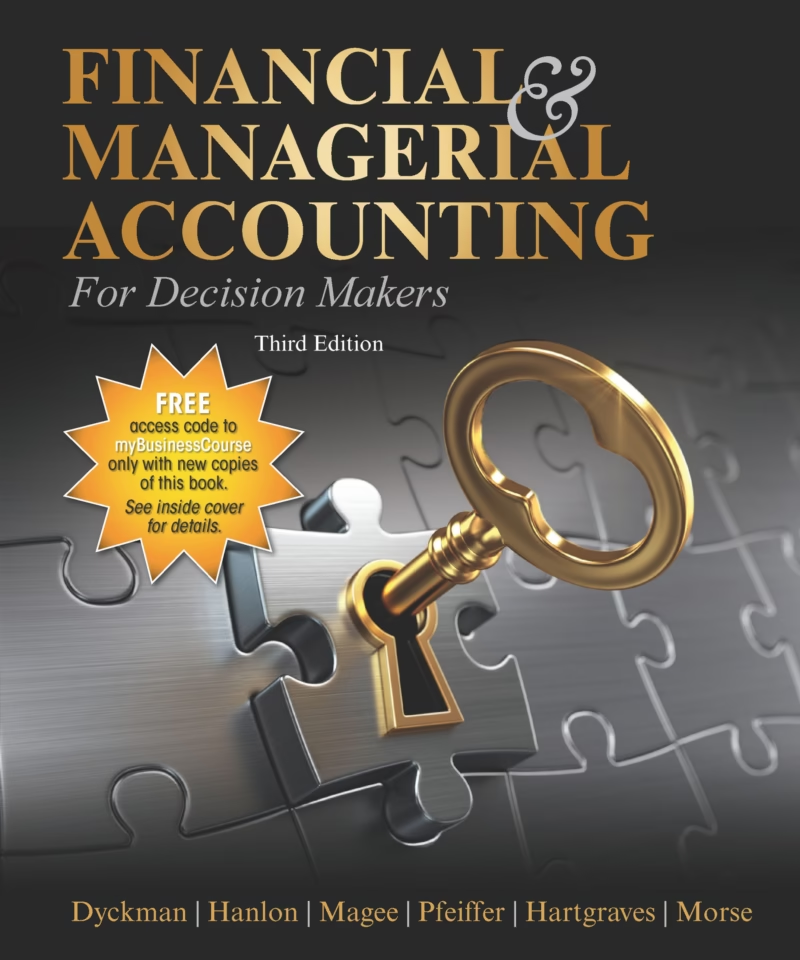Test Bank For Intermediate Accounting, Volume 1, 13th Canadian Edition Donald E. Kieso
$30.00 & Free Shipping
ISBN: 978-1-119-74045-2 November 2021 912 Pages
Free shipping on orders over $50!
- Satisfaction Guaranteed
- No Hassle Refunds
- Secure Payments
Description
TABLE OF CONTENTS
Preface vi
1 The Canadian Financial Reporting Environment 1-1
Capitalizing on Financial Reporting 1-1
Preview of Chapter 1 1-3
1.1 Financial Statements and Financial Reporting 1-3
Accounting and Capital Allocation 1-4
Stakeholders 1-5
Objective of Financial Reporting 1-6
Information Asymmetry 1-9
1.2 Standard Setting 1-11
Need for Standards 1-11
Parties Involved in Standard Setting 1-12
1.3 Generally Accepted Accounting Principles 1-17
GAAP Hierarchy 1-17
Professional Judgement 1-18
1.4 Challenges and Opportunities for the Accounting Profession 1-18
Impact of Technology 1-20
Sustainability Reporting 1-21
Oversight in the Capital Marketplace 1-23
Centrality of Ethics 1-24
Standard Setting in a Political Environment 1-25
Principles versus Rules 1-26
Conclusion 1-26
2 Conceptual Framework Underlying Financial Reporting 2-1
Measuring the Unconventional 2-1
Preview of Chapter 2 2-3
2.1 Conceptual Framework 2-3
Rationale for a Conceptual Framework 2-3
Development of the Conceptual Framework 2-4
Information Asymmetry Revisited 2-5
Objective of Financial Reporting 2-5
2.2 Qualitative Characteristics of Useful Information 2-6
Fundamental Qualitative Characteristics 2-6
Enhancing Qualitative Characteristics 2-13
Trade-offs 2-14
2.3 Elements of Financial Statements 2-14
Assets 2-15
Liabilities 2-16
Equity 2-17
Revenues/Income 2-18
Expenses 2-18
Gains/Losses 2-18
2.4 Foundational Principles 2-19
Recognition/Derecognition 2-20
Measurement 2-25
Presentation and Disclosure 2-32
2.5 Financial Reporting Issues 2-34
Principles-Based Approach 2-35
Financial Engineering 2-35
Fraudulent Financial Reporting 2-36
2.6 IFRS/ASPE Comparison 2-37
Looking Ahead 2-37
3 Data, Decisions, and Measurement 3-1
How CEO Travel Patterns Can Be Used to Predict Mergers and Acquisitions 3-1
Preview of Chapter 3 3-3
3.1 Data and Decisions 3-3
Data, Digitization, and Digitalization 3-3
Decision-Making in Financial Reporting 3-5
3.2 Measuring Financial Statement Elements 3-10
Valuation Techniques 3-10
Value in Use Measurements 3-15
Disclosures Relating to Measurement 3-16
3.3 Measuring Fair Value Using IFRS 13 3-17
3.4 Present Value Concepts 3-20
The Nature of Interest 3-20
Fundamental Variables in Present Value Calculations 3-21
Different Ways to Perform the Calculations 3-23
Some Additional Calculations 3-31
3.5 IFRS/ASPE Comparison 3-33
A Comparison of IFRS and ASPE 3-34
4 Reporting Financial Performance 4-1
Making Money out of Thin Air 4-1
Preview of Chapter 4 4-3
4.1 Performance 4-3
Business Models and Industries 4-3
Communicating Information about Performance 4-7
4.2 Quality of Earnings/Information 4-8
4.3 Measurement of Income 4-14
4.4 Discontinued Operations 4-16
Component of an Enterprise 4-16
Assets Held for Sale 4-17
Measurement and Presentation 4-18
4.5 The Statement of Income and the Statement of Comprehensive Income 4-20
Presentation 4-20
4.6 The Statement of Retained Earnings and the Statement of Changes in Equity 4-30
Presentation of the Statement of Retained Earnings 4-31
Presentation of the Statement of Changes in Equity 4-32
4.7 Disclosure and Analytics 4-34
Disclosure 4-34
Analytics 4-34
Non-GAAP Measures 4-35
Other Key Measures 4-35
4.8 IFRS/ASPE Comparison 4-36
A Comparison of IFRS and ASPE 4-36
Looking Ahead 4-37
Appendix 4A Application of the Cash and Accrual Bases of Accounting 4-37
Differences between Cash and Accrual Bases 4-37
Conversion from Cash Basis to Accrual Basis 4-39
Theoretical Weaknesses of the Cash Basis 4-42
5 Financial Position and Cash Flows 5-1
Toward Better Disclosure 5-1
Preview of Chapter 5 5-3
5.1 Usefulness of the Statements of Financial Position and Cash Flows from a Business Perspective 5-4
Analyzing a Statement of Financial Position 5-4
Assessing Earnings Quality 5-4
Assessing the Creditworthiness of Companies 5-4
5.2 Usefulness and Limitations of the Statement of Financial Position 5-5
Usefulness 5-5
Limitations 5-6
5.3 Classification in the Statement of Financial Position 5-7
Monetary versus Nonmonetary Assets and Liabilities 5-8
Financial Instruments 5-8
Elements of the Statement of Financial Position 5-9
5.4 Preparation of the Classified Statement of Financial Position (Balance Sheet) 5-11
Current Assets 5-12
Non-current Investments 5-17
Property, Plant, and Equipment 5-17
Intangible Assets and Goodwill 5-19
Other Assets 5-20
Current Liabilities 5-20
Long-Term Debt and Liabilities 5-22
Owners’ Equity 5-22
Statement of Financial Position Format 5-24
5.5 Other Required Disclosures 5-25
Contingencies and Provisions 5-25
Accounting Policies 5-26
Contractual Obligations 5-26
Additional Detail 5-27
Subsequent Events 5-27
5.6 Techniques of Disclosure 5-27
Parenthetical Explanations 5-27
Notes 5-28
Cross-References and Contra Items 5-28
Supporting Schedules 5-29
Terminology 5-29
5.7 Purpose, Content, and Format of a Statement of Cash Flows 5-29
5.8 Preparation of the Statement of Cash Flows 5-32
5.9 Usefulness of the Statement of Cash Flows 5-37
Financial Liquidity 5-38
Financial Flexibility 5-38
Perspectives 5-38
5.10 IFRS/ASPE Comparison 5-41
A Comparison of IFRS and ASPE 5-41
Looking Ahead 5-42
Appendix 5A Ratio Analysis: A Reference 5-42
Business Risks 5-42
Financial Ratios 5-43
6 Revenue Recognition 6-1
Revenue Recognition in the Digital World 6-1
Preview of Chapter 6 6-4
6.1 Understanding the Nature of Sales Transactions from a Business Perspective 6-4
Economics of Sales Transactions 6-4
Legalities of Sales Transactions 6-9
Information for Decision-Making 6-10
6.2 The Asset-Liability Approach to Revenue
Recognition: An Overview of the Five-Step Process 6-11
6.3 Identifying the Contract with Customers—Step 1 6-13
Basic Accounting 6-14
Contract Modifications 6-15
6.4 Identifying Separate Performance Obligations—Step 2 6-15
Material Rights 6-18
Warranties 6-19
Upfront Fees 6-21
Series of Goods and Services That Are Substantially the Same 6-21
6.5 Determining the Transaction Price—Step 3 6-22
Variable Consideration 6-22
Time Value of Money 6-27
Non-cash Consideration 6-28
Consideration Paid or Payable to Customers 6-28
6.6 Allocating the Transaction Price to Separate Performance Obligations—Step 4 6-29
6.7 Recognizing Revenue When (or As) Each Performance Obligation Is Satisfied—Step 5 6-33
6.8 Earnings Approach to Revenue Recognition 6-37
Selling Goods 6-37
Selling Services 6-39
Measurability and Collectibility 6-39
6.9 Other Revenue Recognition Issues 6-39
Repurchase Agreements 6-39
Bill-and-Hold Arrangements 6-40
Principal-Agent Relationships 6-41
Consignments 6-42
Summary of Other Revenue Recognition Issues 6-43
6.10 Presentation, Disclosure, and Analytics 6-44
Presentation and Disclosure 6-44
Analytics 6-47
6.11 IFRS/ASPE Comparison 6-49
A Comparison of IFRS and ASPE 6-49
Looking Ahead 6-50
Appendix 6A Long-Term Contracts 6-51
Percentage-of-Completion Method 6-51
Measuring the Progress Toward Completion 6-52
Zero-Profit Method 6-57
Completed-Contract Method 6-58
Losses on Long-Term Contracts 6-59
Loss in Current Period on a Profitable Contract 6-59
Loss on an Unprofitable Contract 6-60
7 Cash and Receivables 7-1
Managing Receivables in Risky Times 7-1
Preview of Chapter 7 7-3
7.1 Understanding Cash and Accounts Receivable 7-4
How Do Companies Manage and Control Cash? 7-4
What Types of Companies Have Extensive Accounts Receivable? 7-4
What Are the Types of Accounts Receivable? 7-6
How Do Companies Manage Accounts Receivable? 7-6
7.2 Cash 7-7
What Is Included in Cash? 7-8
Reporting Cash 7-8
Summary of Cash-Related Items 7-11
7.3 Receivables 7-12
7.4 Recognition and Measurement of Accounts Receivable 7-14
Trade Discounts 7-15
Cash Discounts (Sales Discounts) 7-15
Sales Returns and Allowances 7-15
Non-Recognition of Interest Element 7-16
Measurement of Accounts Receivable after Acquisition 7-17
7.5 Impairment of Accounts Receivable 7-17
Estimating Uncollectible Trade Accounts Receivable 7-17
Allowance Method 7-19
Effects on Accounts 7-22
Direct Write-Off Method 7-23
7.6 Notes and Loans Receivable 7-23
Recognition and Measurement of Short-Term Notes and Loans Receivable 7-23
Recognition and Measurement of Long-Term Notes and Loans Receivable 7-25
7.7 Derecognition of Receivables 7-32
Secured Borrowings 7-33
Sales of Receivables 7-33
Securitized Receivables—Transparency 7-39
7.8 Presentation, Disclosure, and Analytics 7-39
Presentation and Disclosure 7-39
Analytics 7-41
7.9 IFRS/ASPE Comparison 7-42
A Comparison of IFRS and ASPE 7-42
Looking Ahead 7-43
Appendix 7A Methods for Controlling Cash 7-44
Management and Control of Cash 7-44
Using Bank Accounts 7-44
The Imprest Petty Cash System 7-45
Physical Protection of Cash Balances 7-46
Reconciliation of Bank Balances 7-46
8 Inventory 8-1
Inventory Management after COVID-19 8-1
Preview of Chapter 8 8-4
8.1 Understanding Inventory 8-4
What Types of Companies Have Inventory? 8-4
Inventory Categories 8-4
Inventory Planning and Control 8-5
Information for Decision-Making 8-5
8.2 Recognition of Physical Goods Included in Inventory 8-7
Accounting Definition of Inventory 8-7
Goods Included in Inventory 8-8
8.3 Inventory Errors 8-14
Ending Inventory Misstated 8-14
Purchases and Inventory Misstated 8-16
8.4 Measurement of Inventory—Costs Included 8-17
Volume Rebates 8-17
Product Costs 8-19
8.5 Measurement and Inventory Accounting Systems 8-21
Perpetual System 8-21
Periodic System 8-22
Comparing Perpetual and Periodic Systems 8-22
Supplementary System—Quantities Only 8-23
8.6 Measurement and Cost Formulas 8-23
Specific Identification 8-24
Weighted Average Cost 8-26
First-In, First-Out (FIFO) 8-27
Choice of Cost Formula 8-29
Last-In, First-Out (LIFO) 8-29
8.7 Measurement and the Lower of Cost and Net Realizable Value (LC&NRV) Principle 8-30
What Is Net Realizable Value? 8-31
Application of the LC&NRV Principle 8-31
Evaluation of the LC&NRV Principle 8-35
8.8 Exceptions to Lower of Cost and Net Realizable Value 8-35
Inventories Measured at Net Realizable Value 8-35
Inventories Measured at Fair Value Less Costs to Sell 8-36
8.9 Measuring Inventory Using Estimates 8-40
The Need for Estimates 8-40
Gross Profit Method 8-41
8.10 Presentation, Disclosure, and Analytics 8-43
Presentation and Disclosure of Inventories 8-43
Analytics 8-44
8.11 IFRS/ASPE Comparison 8-47
A Comparison of IFRS and ASPE 8-47
Looking Ahead 8-48
Appendix 8A The Retail Inventory Method of Estimating Inventory Cost 8-48
Retail Method Terminology 8-49
Special Items 8-51
Evaluation of Retail Inventory Method 8-52
Appendix 8B Accounting Guidance for Specific Inventory 8-53
9 Investments 9-1
Environmental, Social, and Governance Investing 9-1
Preview of Chapter 9 9-3
9.1 Understanding Investments 9-4
Types of Investments 9-4
Types of Companies That Have Investments 9-5
Information for Decision-Making 9-9
Measurement: Overview 9-9
9.2 Measurement—Cost/Amortized Cost Model 9-11
Investments in Shares of Other Entities 9-11
Investments in Debt Instruments of Other Entities 9-12
9.3 Measurement—Fair Value through Net Income (FV-NI) Model 9-16
9.4 Measurement—Fair Value through Other Comprehensive Income (FV-OCI) Model 9-21
Investments in Shares of Other Entities 9-23
Investments in Debt Instruments of Other Entities 9-25
9.5 Measurement—Impairment Models 9-28
Incurred Loss Impairment Model 9-28
Expected Loss Impairment Model 9-29
Fair Value Loss Impairment Model 9-33
Summary of Impairment Models 9-33
9.6 Strategic Investments—Investments in Associates 9-34
Significant Influence 9-34
Equity Method 9-35
Summary of Accounting Standards for Associates 9-39
9.7 Strategic Investments—Investments in Subsidiaries 9-40
9.8 Presentation, Disclosure, and Analytics 9-41
Presentation and Disclosure 9-42
Analytics 9-44
9.9 IFRS/ASPE Comparison 9-45
A Comparison of IFRS and ASPE 9-46
10 Property, Plant, and Equipment: Accounting Model Basics 10-1
Fair Value Accounting Makes Sense for BAM 10-1
Preview of Chapter 10 10-3
10.1 Definition and Recognition of Property, Plant, and Equipment 10-3
Property, Plant, and Equipment—Business Perspective 10-4
Property, Plant, and Equipment—Characteristics 10-4
10.2 Cost Elements 10-6
Self-Constructed Assets 10-7
Borrowing Costs 10-8
Dismantling and Restoration Costs 10-9
10.3 Measurement of Cost for Nonmonetary Exchange 10-10
Cash Discounts Not Taken 10-10
Deferred Payment Terms 10-11
Lump-Sum Purchases 10-12
Nonmonetary Exchanges 10-13
Contributed Assets and Government Grants 10-18
10.4 Measurement of Costs Associated with Specific Assets 10-19
Land 10-20
Buildings 10-20
Leasehold Improvements 10-20
Equipment 10-21
Investment Property 10-21
Natural Resource Properties 10-21
Biological Assets 10-22
10.5 Measurement after Acquisition 10-24
Cost and Revaluation Models 10-25
Fair Value Model 10-28
10.6 Costs Incurred after Acquisition 10-31
Additions 10-32
Replacements, Major Overhauls, and Inspections 10-32
Rearrangement and Reinstallation 10-35
Repairs 10-35
10.7 IFRS/ASPE Comparison 10-36
A Comparison of IFRS and ASPE 10-36
Looking Ahead 10-38
Appendix 10A Capitalization of Borrowing Costs 10-39
Qualifying Assets 10-39
Capitalization Period 10-40
Avoidable Borrowing Costs 10-40
Disclosures 10-44
Appendix 10B Revaluation: The Proportionate Method 10-44
11 Depreciation, Impairment, and Disposition 11-1
Accounting for Assets That Become Liabilities 11-1
Preview of Chapter 11 11-3
11.1 The Importance of Depreciation, Impairment, and Disposition from a Business Perspective 11-3
11.2 Depreciation 11-4
Factors Considered in the Depreciation Process 11-5
11.3 Depreciation—Methods of Allocation and Calculation 11-8
Straight-Line Method 11-9
Diminishing Balance Method 11-10
Activity Methods 11-12
Other Methods 11-13
11.4 Depletion of Mineral Resources 11-14
Pattern of Depletion 11-15
Estimating Recoverable Reserves 11-16
Liquidating Dividends 11-17
11.5 Other Depreciation Issues 11-18
Depreciation and Partial Periods 11-18
Revision of Depreciation Rates 11-20
11.6 Impairment 11-22
Indicators of Impairment 11-24
Impairment—Measurement and Recognition Models 11-24
Asset Groups and Cash-Generating Units 11-28
11.7 Held for Sale and Derecognition 11-30
Long-Lived Assets to Be Disposed of by Sale 11-31
Derecognition 11-31
11.8 Presentation, Disclosure, and Analytics 11-33
Presentation and Disclosure 11-33
Analytics 11-35
11.9 IFRS/ASPE Comparison 11-38
A Comparison of IFRS and ASPE 11-38
Looking Ahead 11-39
Appendix 11A Depreciation and Income Tax 11-40
Capital Cost Allowance Method 11-40
12 Intangible Assets and Goodwill 12-1
Goodwill Impairment Is on the Line 12-1
Preview of Chapter 12 12-3
12.1 The Business Importance and Characteristics of Goodwill and Intangible Assets 12-3
Characteristics of Goodwill 12-4
Characteristics of Intangible Assets 12-5
12.2 Recognition and Measurement of Intangible Assets at Acquisition 12-6
Purchased Intangibles 12-6
Intangibles Purchased in a Business Combination 12-7
Prepayments 12-7
12.3 Recognition and Measurement of Internally Developed Intangible Assets 12-9
Identifying Research and Development Phase Activities 12-10
Accounting for Research Phase Costs 12-10
Accounting for Development Phase Costs 12-11
Costs Included and Excluded 12-11
12.4 Recognition and Measurement of Intangible Assets after Acquisition 12-12
Limited-Life Intangibles 12-14
Indefinite-Life Intangibles 12-16
12.5 Specific Intangibles 12-16
Marketing-Related Intangible Assets 12-16
Customer-Related Intangible Assets 12-19
Artistic-Related Intangible Assets 12-19
Contract-Based Intangible Assets 12-20
Technology-Based Intangible Assets 12-21
12.6 Impairment and Derecognition 12-23
Impairment of Limited-Life Intangibles 12-23
Impairment of Indefinite-Life Intangibles 12-24
Derecognition 12-25
12.7 Goodwill—Recognition and Measurement 12-25
Internally Generated Goodwill 12-25
Purchased Goodwill 12-26
Bargain Purchase 12-28
Valuation after Acquisition 12-29
12.8 Goodwill—Impairment 12-31
12.9 Presentation, Disclosure, and Analytics 12-33
Presentation and Disclosure 12-33
Analytics 12-36
12.10 IFRS/ASPE Comparison 12-38
A Comparison of IFRS and ASPE 12-38
Looking Ahead 12-39
Appendix 12A Valuing Goodwill 12-40
Excess-Earnings Approach 12-40
Total-Earnings Approach 12-44
Other Valuation Methods 12-45
Appendix A Time Value of Money Tables AP-1
Appendix B A Summary of the Case Primer AP-6
Appendix C* The Accounting Information System AP-8
*Full text available in the ebook and in Wiley’s online course.
Online content only.
Appendix C The Accounting Information System C-1
Appendix D Specimen Financial Statements D-1
Appendix E Coverage of the CPA Competency Map Knowledge Supplement E-1
Glossary G-1
Company Index I-1
Subject Index I-5





 Solution Manuals for Advanced Accounting, 4e BY HOPKINS, HALSEY
Solution Manuals for Advanced Accounting, 4e BY HOPKINS, HALSEY